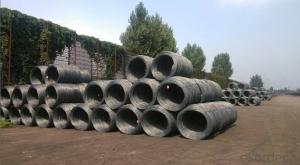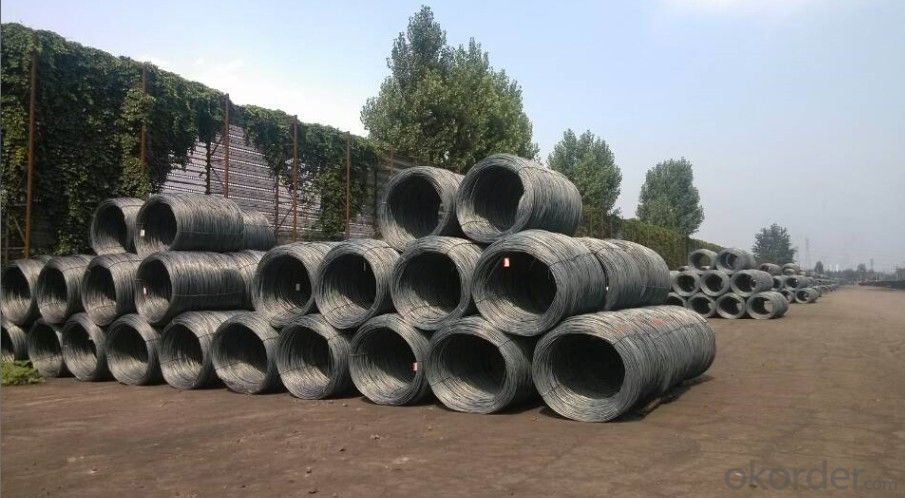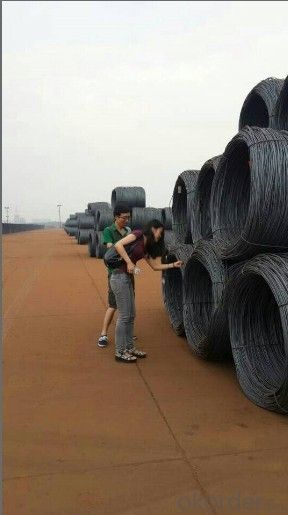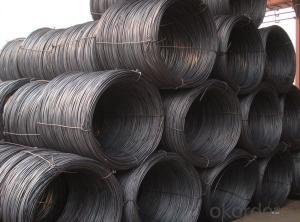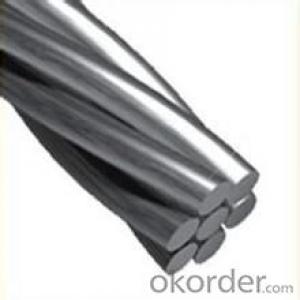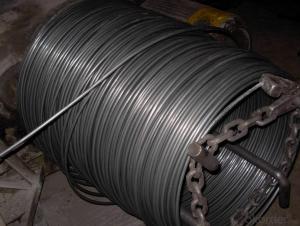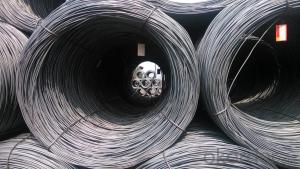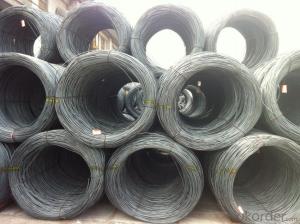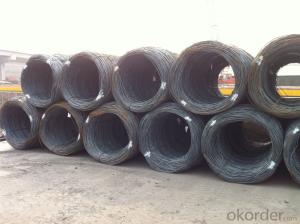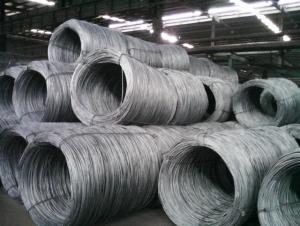Steel Wire Rods High Carbon Hot Rolled First Class Quality Best Seller
- Loading Port:
- Tianjin
- Payment Terms:
- TT OR LC
- Min Order Qty:
- 500 m.t.
- Supply Capability:
- 30000 m.t./month
OKorder Service Pledge
OKorder Financial Service
You Might Also Like
1.Structure of Wire Rod Steel for Construction Description
Wire rod steel is widely used for commercial building structure, pre-engineering buildings, machinery support structures, prefabricated structure, medium scale bridges and so on. We have supplied this product for many years and gained widespread reputation.
2.Main Features of the Wire Rod Steel for Construction
fasteners, bolts, rivets, screws,
general purpose wires,
electrode wires, industrial wires, agriculture wires,
bush wires, chain rivet wires,
detonator wire,
Umbrella ribs, upholstery wires, cycle spokes, needle wires, heald wires, staple pin Wire, safety pin wires
ACSR wires, earth wires,
tyre and hose reinforcement wires,
prestressed concrete wire, springs and rope wires,
card clothing wires,
vineyard wires,
ball bearing quality
Automobile parts like screw, fasteners, bush, spline, socket, connecting rod, shaft, gear, rivets, engine shaft, connecting rod, spindles, gears, etc.
3.Wire Rod Steel for Construction Images
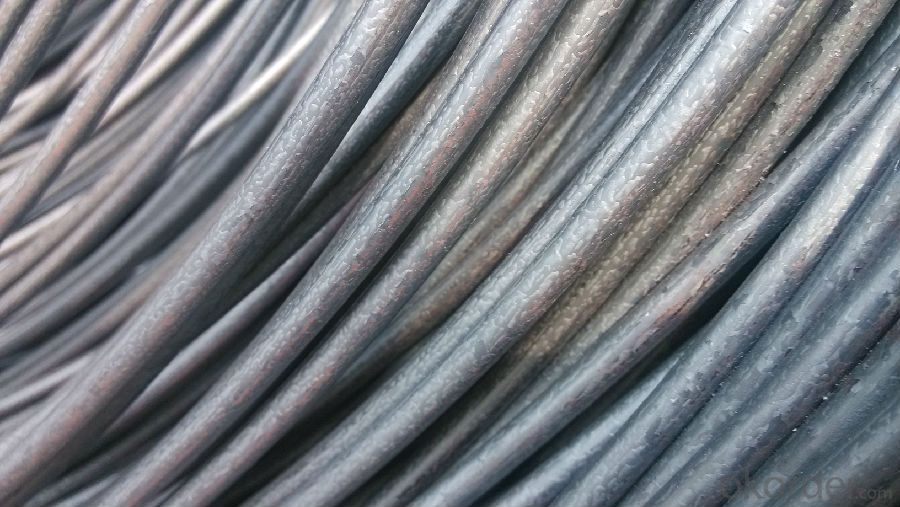
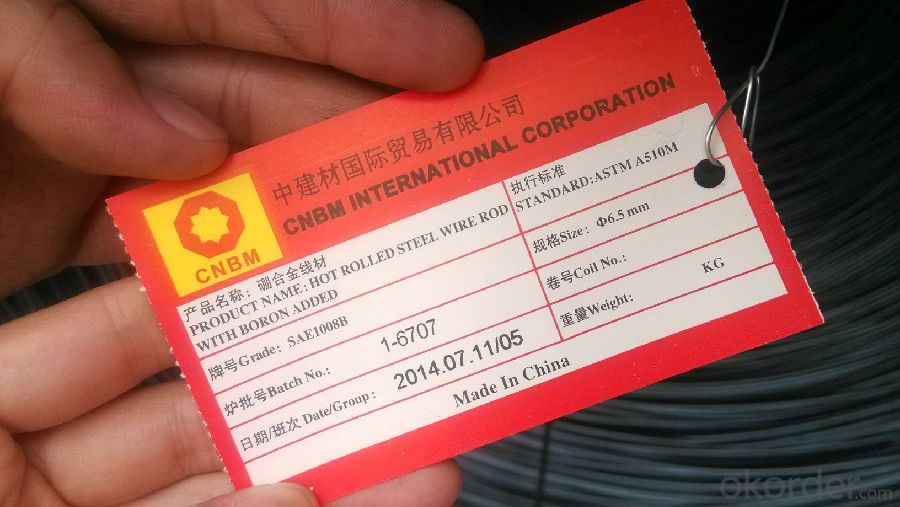
4.Wire Rod Steel for Construction Specification
Grade | Chemical Composition(%) | |||||
C | Mn | Si | P | S | B | |
SAE1008B | 0.10Max | 0.3-0.5 | 0.15Max | 0.040Max | 0.050Max | 0.0008Min |
Mechanical Properties | ||||||
Yield strength(N/mm2) | Tensile strength (N/mm2) | Elongation(%) | ||||
≥195 | 315-430 | ≥30 | ||||
Grade | Chemical Composition(%) | |||||
C | Mn | Si | P | S | B | |
SAE1006B | 0.03-0.07 | ≤0.32 | ≤0.30 | ≤0.040 | ≤0.045 | >0.0008 |
Mechanical Properties | ||||||
Yield strength(N/mm2) | Tensile strength(N/mm2) | Elongation(%) | ||||
≥195 | 315-430 | ≥30 | ||||
5.FAQ of Wire Rod Steel for Construction
We have organized several common questions for our clients,may help you sincerely:
1.What is your minimum order quantity ?
Our MOQ is 500mt for each size. And we will consider to give more discount if you make big order like 10000 tons and more. Further more, the more appropriate payment term your offer the better price we can provide.
2.Please tell me the daily output and wire rod mill’s brand ?
Our daily output is 4000mt/day and our rolling mill from Germany’s SMS MEER
3.Which countries are your main sales?
Thanks to the professional international trade team, solid distribution channel and long – term cooperation customers, our market share in overseas realizes a tremendous growth, now we already became a main player in Middle East and South East Asia. Meanwhile, we are also the biggest supplier of Pre-painted galvanized steel coil in Philippines, Saudi Arabia, United Arab Emirates, Iran, Sudan etc.
- Q: What are the common material specifications for steel wire rod?
- The common material specifications for steel wire rod are typically determined by the specific requirements of the industry or application in which the wire rod will be used. However, there are some general material specifications that are commonly found in steel wire rod. One of the most important material specifications for steel wire rod is its chemical composition. Steel wire rod is typically made from carbon steel, which contains varying amounts of carbon and other alloying elements such as manganese, silicon, and sulfur. The exact composition of the steel wire rod will depend on the desired mechanical properties and the intended application. Another important material specification for steel wire rod is its size and shape. Steel wire rod is generally produced in coils with diameters ranging from a few millimeters to several centimeters. The specific size and shape of the wire rod will depend on the requirements of the end product, such as the desired strength, flexibility, and conductivity. Furthermore, the mechanical properties of the steel wire rod are also specified. These properties include the tensile strength, yield strength, and elongation, which determine the wire rod's ability to withstand forces and deformations without breaking. The mechanical properties are typically achieved through specific manufacturing processes and heat treatments. Other common material specifications for steel wire rod may include surface quality requirements, such as smoothness, cleanliness, and absence of defects. Additionally, certain industries or applications may have specific requirements for corrosion resistance, electrical conductivity, or thermal conductivity, which would also be specified. It is important to note that the exact material specifications for steel wire rod can vary significantly depending on the specific industry or application. Therefore, it is crucial to carefully review the requirements and consult industry standards or experts to ensure the appropriate material specifications are met for the intended use of the steel wire rod.
- Q: What are the common production processes for xenon-coated steel wire rod?
- The common production processes for xenon-coated steel wire rod include cleaning and pre-treatment, application of the xenon coating through a specialized coating process, curing or drying of the coating, and quality control checks to ensure the coating is applied uniformly and meets required standards.
- Q: What are the different microscopy techniques used for steel wire rod analysis?
- Steel wire rod analysis can be performed using several microscopy techniques, which offer valuable insights into the microstructure, composition, and defects of the wire rod. 1. Utilizing optical microscopy, researchers can observe the wire rod's microstructure by employing visible light. This technique allows for the examination of grain size, grain boundaries, and visible defects like cracks or inclusions. 2. Scanning Electron Microscopy (SEM) involves directing a focused beam of electrons onto the wire rod's surface to capture high-resolution images. Through SEM, one can gather information about surface morphology, elemental composition, and the presence of surface defects or contaminants. 3. Transmission Electron Microscopy (TEM) is a powerful technique that involves passing a beam of electrons through a thin section of the wire rod to obtain detailed images of its internal microstructure. TEM provides information about crystal structure, grain boundaries, and the presence of atomic-level precipitates or defects. 4. Electron Backscatter Diffraction (EBSD) combines SEM with crystallography to determine the wire rod's orientation and grain structure. This technique offers insights into crystallographic texture, grain size distribution, and any deformation or recrystallization that might have occurred during processing. 5. X-ray Diffraction (XRD) involves directing X-rays onto the wire rod's surface to analyze its crystal structure. XRD provides information about phase composition, crystallographic orientation, and any residual stress or strain present. 6. Atomic Force Microscopy (AFM) employs a small probe to scan the wire rod's surface and capture high-resolution images. By utilizing AFM, researchers can gather information about surface topography, roughness, and the presence of surface defects such as scratches or pits. By employing these various microscopy techniques, researchers and engineers in the steel industry can develop a comprehensive understanding of microstructure, composition, and defects in steel wire rods. This understanding is essential for quality control, process optimization, and material development purposes.
- Q: What are the different types of wire drawing dies used for steel wire rod?
- Steel wire rod can be drawn using several types of wire drawing dies. These dies vary in their composition and characteristics. Here are the different types commonly used: 1. Single crystal natural diamond dies: These dies, made from a single crystal diamond, are renowned for their exceptional hardness and resistance to wear. They are suitable for drawing both high carbon steel wire rod and stainless steel wire rod. 2. Polycrystalline diamond (PCD) dies: PCD dies are crafted by bonding multiple small diamond crystals together. They offer good wear resistance and can be used for drawing steel wire rod with intermediate carbon content. 3. Tungsten carbide dies: Utilizing tungsten carbide, a tough and durable material, these dies are often employed for wire drawing. They can handle high carbon steel wire rod and are capable of withstanding high pressures and temperatures. 4. Natural diamond dies with carbide support: These dies possess a core made of natural diamond, providing excellent wear resistance, while a carbide support structure adds strength and stability. They are suitable for drawing steel wire rod with high carbon content. 5. PCD dies with carbide support: Similar to the previous type, these dies have a PCD core and a carbide support structure. They offer good wear resistance and are suitable for steel wire rod with intermediate carbon content. 6. Polycrystalline diamond composite (PDC) dies: PDC dies are manufactured by sintering diamond particles with a binder material. They are well-known for their high wear resistance and are commonly used for drawing steel wire rod with low to medium carbon content. Each type of wire drawing die possesses unique advantages and is suitable for specific applications, depending on the carbon content and other properties of the steel wire rod being drawn.
- Q: How is steel wire rod used in the manufacturing of wire forms for elevator cables?
- Steel wire rod is used in the manufacturing of wire forms for elevator cables as it serves as the primary material for creating the strong and durable wires that make up the cables. The steel wire rod goes through a series of processes such as drawing, annealing, and stranding to form the individual wires. These wires are then twisted or braided together to create the wire forms that provide the necessary strength and flexibility for elevator cables to support the heavy loads and ensure safe and reliable transportation.
- Q: What are the advantages of using galvanized steel wire rod?
- There are several advantages of using galvanized steel wire rod. Firstly, galvanization provides a protective zinc coating to the steel, making it highly resistant to corrosion and rust. This increases the lifespan of the wire rod and reduces the need for frequent replacements. Secondly, galvanized steel wire rod has excellent strength and durability, making it ideal for various applications such as fencing, construction, and electrical wiring. Additionally, galvanized steel wire rod is cost-effective as it requires minimal maintenance and has a lower overall lifetime cost compared to other materials. Lastly, the galvanized coating on the wire rod provides an aesthetically pleasing finish, making it suitable for decorative purposes as well.
- Q: How are steel wire rods used in the manufacturing of wire brushes for cleaning purposes?
- Steel wire rods are an essential component in the manufacturing of wire brushes for cleaning purposes. These wire rods are typically made from high-quality steel, known for its strength, durability, and flexibility. To create wire brushes, the steel wire rods undergo a series of processes. First, the wire rods are carefully selected based on their composition and tensile strength. They are then passed through a wire drawing machine, which reduces their diameter and increases their length. This process allows for the creation of thin and long wires that are perfect for brush bristles. Once the wires are drawn, they are straightened and cut to the desired length. The lengths can vary depending on the type of brush being produced. The straightened wires are then inserted into a metal ferrule or twisted together to form a bundle, depending on the brush design. The wire bristles are then attached to a handle or base, which can be made of wood, plastic, or metal. This assembly process can be done manually or with the help of specialized machinery. The bristles are secured tightly to ensure they do not come loose during use. Steel wire rods are favored for manufacturing wire brushes due to their excellent cleaning properties. The strength and flexibility of steel allow the bristles to effectively remove dirt, grime, and debris from various surfaces. They can be used on a wide range of materials, including metal, wood, and concrete. Wire brushes made from steel wire rods are commonly used for cleaning applications such as removing rust, paint, or corrosion from surfaces, preparing surfaces for painting or welding, cleaning welding joints, and scrubbing hard-to-reach areas. They are also utilized in industries such as automotive, manufacturing, construction, and maintenance. In summary, steel wire rods play a crucial role in the manufacturing of wire brushes for cleaning purposes. Their strength, durability, and flexibility make them ideal for creating effective and reliable cleaning tools. Whether it's for removing rust, cleaning welds, or scrubbing surfaces, wire brushes made from steel wire rods are an essential tool in many industries and households.
- Q: What is the average carbon content in steel wire rod?
- The average carbon content in steel wire rod typically ranges from 0.05% to 0.25%.
- Q: How are surface defects in steel wire rod repaired?
- Different methods can be used to repair surface defects in steel wire rods, depending on the type and extent of the defect. Common defects include scale, cracks, pits, and scratches. The following are some techniques used to address these defects: 1. Grinding and polishing: Scratches and pits can be repaired through grinding and polishing. This involves removing the damaged layer of steel and using abrasive tools to smooth the surface. The process is repeated until the defect is completely eliminated, and the surface achieves the desired finish. 2. Heat treatment: Heat treatment can be employed to repair cracks. This method involves subjecting the steel wire rod to controlled heating and cooling processes, which alter its physical and mechanical properties. Heat treatment helps close the cracks and enhance the overall integrity of the wire rod. 3. Mechanical removal: Mechanical removal methods are used for larger defects like scale or excessive surface irregularities. Specialized tools or machinery are utilized to physically remove the defective portion of the wire rod. The remaining surface is then treated to ensure it meets the required specifications. 4. Chemical treatment: Chemical treatment methods can be utilized to repair surface defects such as rust or corrosion. Appropriate chemicals or coatings are applied to the affected area to remove the corrosion and prevent further deterioration. The treated surface is then cleaned and prepared for further processing or use. It should be noted that the repair process for surface defects may vary depending on the specific requirements and standards of the steel wire rod industry. Manufacturers and technicians adhere to industry guidelines and quality control measures to ensure the repaired wire rods meet the necessary specifications for their intended applications.
- Q: How are steel wire rods used in the production of fishing nets for catching fish?
- Steel wire rods are used in the production of fishing nets for catching fish as they provide strength and durability to the net structure. These rods are typically woven or twisted together to form the main framework of the net, ensuring it can withstand the weight and force of the fish caught. Additionally, the steel wire rods help maintain the shape and flexibility of the net, allowing for effective fishing operations.
Send your message to us
Steel Wire Rods High Carbon Hot Rolled First Class Quality Best Seller
- Loading Port:
- Tianjin
- Payment Terms:
- TT OR LC
- Min Order Qty:
- 500 m.t.
- Supply Capability:
- 30000 m.t./month
OKorder Service Pledge
OKorder Financial Service
Similar products
Hot products
Hot Searches
Related keywords
